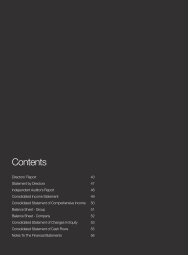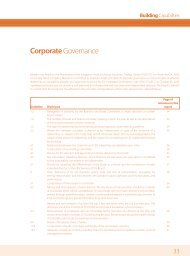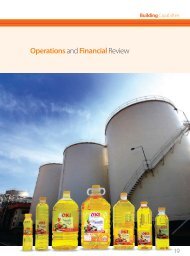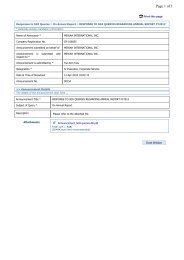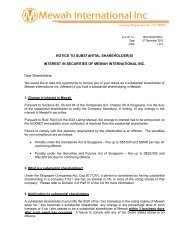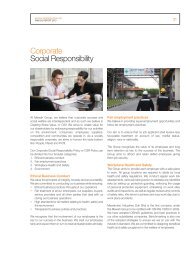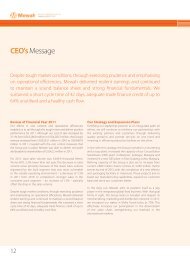Financial Statements - Mewah Group
Financial Statements - Mewah Group
Financial Statements - Mewah Group
You also want an ePaper? Increase the reach of your titles
YUMPU automatically turns print PDFs into web optimized ePapers that Google loves.
Building Capabilities<br />
Notes to the <strong>Financial</strong> <strong>Statements</strong><br />
For the financial year ended 31 December 2011<br />
2. Significant accounting policies (continued)<br />
2.9 <strong>Financial</strong> assets (continued)<br />
(d)<br />
Subsequent measurement<br />
Available-for-sale financial assets and financial assets at fair value through profit or loss, are subsequently carried at<br />
fair value. Loans and receivables and held-to-maturity financial assets are subsequently carried at amortised cost<br />
using the effective interest method.<br />
Changes in the fair values of financial assets at fair value through profit or loss including the effects of currency<br />
translation, interest and dividends, are recognised in profit or loss when the changes arise.<br />
Interest and dividend income on available-for-sale financial assets are recognised separately in profit or loss. Changes<br />
in the fair values of available-for-sale debt securities (i.e. monetary items) denominated in foreign currencies are<br />
analysed into currency translation differences on the amortised cost of the securities and other changes; the currency<br />
translation differences are recognised in profit or loss and the other changes are recognised in other comprehensive<br />
income and accumulated in the fair value reserve. Changes in fair values of available-for-sale equity securities (i.e.<br />
non-monetary items) are recognised in other comprehensive income and accumulated in the fair value reserve,<br />
together with the related currency translation differences.<br />
(e)<br />
Impairment<br />
The <strong>Group</strong> assesses at each statement of financial position date whether there is objective evidence that a financial<br />
asset or a group of financial assets is impaired and recognises an allowance for impairment when such evidence<br />
exists.<br />
(i)<br />
Loans and receivables/held-to-maturity financial assets<br />
Significant financial difficulties of the debtor, probability that the debtor will enter bankruptcy, and default or<br />
significant delay in payments are objective evidence that these financial assets are impaired.<br />
The carrying amount of these assets is reduced through the use of an impairment allowance account which<br />
is calculated as the difference between the carrying amount and the present value of estimated future cash<br />
flows, discounted at the original effective interest rate. When the asset becomes uncollectible, it is written<br />
off against the allowance account. Subsequent recoveries of amounts previously written off are recognised<br />
against the same line item in profit or loss.<br />
The impairment allowance is reduced through profit or loss in a subsequent period when the amount of<br />
impairment loss decreases and the related decrease can be objectively measured. The carrying amount of<br />
the asset previously impaired is increased to the extent that the new carrying amount does not exceed the<br />
amortised cost had no impairment been recognised in prior periods.<br />
67



